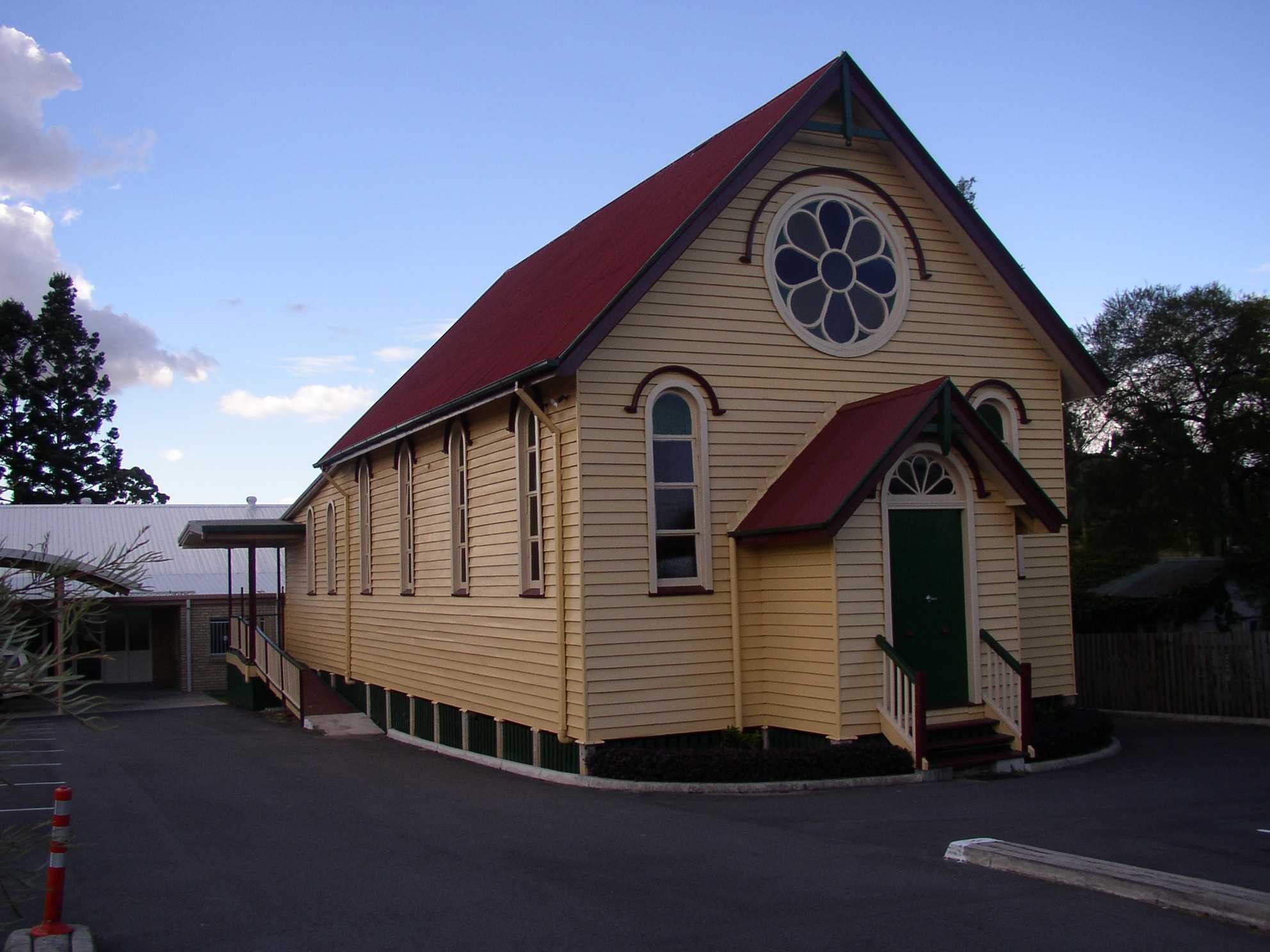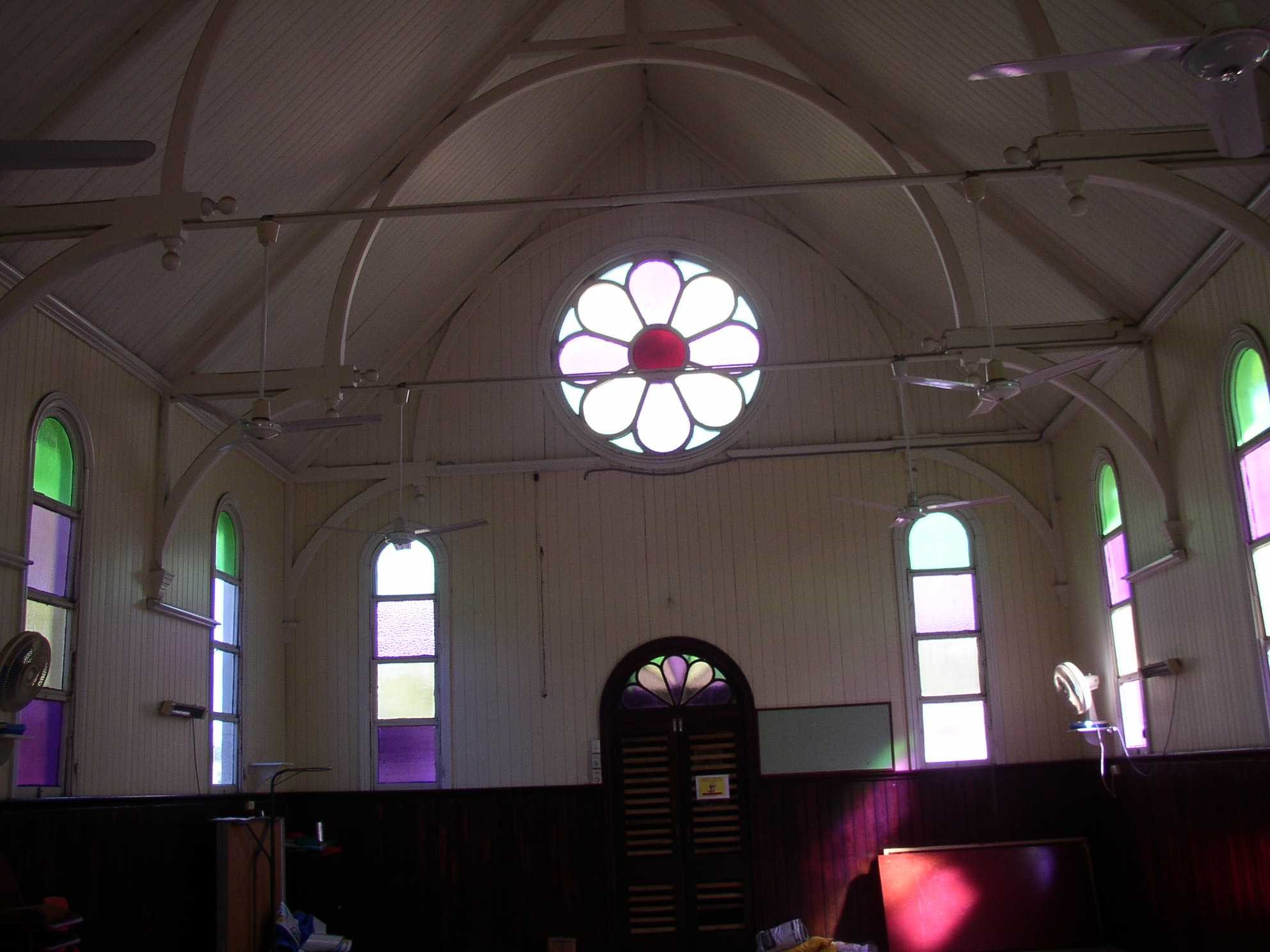Addresses
Type of place
Church
Period
Federation 1890-1914
Style
Carpenter Gothic
Addresses
Type of place
Church
Period
Federation 1890-1914
Style
Carpenter Gothic
This small Federation Carpenter Gothic style timber framed church was built in 1910 after the previous church, constructed on this site in 1863, burned down in 1909. The Bald Hills Presbyterian Church has continued to meet the spiritual needs of the local Presbyterian community for more than 100 years and, with its high quality timbers and rose windows, makes a fine aesthetic contribution to the streetscape.
Lot plan
L1_RP96530
Key dates
Local Heritage Place Since —
Date of Citation —
Construction
Roof: Corrugated iron;Walls: Timber
Criterion for listing
(A) Historical; (D) Representative; (E) Aesthetic; (G) SocialInteractive mapping
Lot plan
L1_RP96530
Key dates
Local Heritage Place Since —
Date of Citation —
Construction
Roof: Corrugated iron;Walls: Timber
Criterion for listing
(A) Historical; (D) Representative; (E) Aesthetic; (G) SocialInteractive mapping
History
The first Presbyterian church in Brisbane was erected by its congregation in 1850, and more churches followed in Brisbane and country towns throughout the next two decades. Early Presbyterianism had a strong association with Scottish immigrants, and a church was often erected in places were Scots settled in numbers. Early landholders in the Bald Hills district were predominantly Scottish and Presbyterian worship is thought to date from the very early 1860s, when services were held in the home of John Stewart. Stewart had arrived in the district in 1857 and with relatives established the first agricultural ventures. Small cropping and timber formed the basis of the settlement until the 1880s, when sugar cane was briefly tried. The cleared forests were then turned to pasture, and dairy farming became the main local industry through to the late 1940s.
In May 1863, the first Presbyterian Church of Bald Hills was built and opened by the Reverend C. Ogg. Three years later Bald Hills was included in Reverend Alexander Caldwell’s charge of Oxley Creek and Fortitude Valley. However from the mid 1870s, the growth of the Presbyterian community slowed dramatically throughout Queensland, and the Convenor of the Church Extension Committee, the Reverend Colin McCulloch, observed in 1881 that "our Church is not extending, but rather the reverse".
By the mid-1880s an economic revival and more stable population provided a basis for a resurgence of the Presbyterian Church in Queensland. The church began to expand in country and metropolitan centres and a number of new churches were built. The Presbyterian community in the Pine River’s district increased during the 1880s and another church was erected at nearby North Pine in 1884. Although the railway was extended to Bald Hills in 1888, irregular timetables and the expense of travel did not see the area develop as ‘a most popular suburb of the metropolis’, as promised by land sale flyers.
In 1889, at a time when Bald Hills township ‘had seen brighter days’, the Presbyterian congregation determined that the position of the Bald Hills church did not meet their requirements and in 1889 it was removed and rebuilt about one hundred yards along the road. It continued to serve the needs of the congregation until 1909 when it was destroyed by fire after a lightening strike.
The present church was erected on the same site in 1910 and opened free of debt. The opening ceremony was performed by his Excellency the Governor of Queensland, Sir William MacGregor on Saturday October 8 and a large gathering of friends and residents from Sandgate, Nundah, North Pine and other adjacent districts attended the opening.
Following the opening the church was described as a handsome building built of the finest quality Queensland hardwood, beech, cedar and pine. The main building at 40ft by 24ft was capable of accommodating 200 people. The walls, 15 feet high, were relieved by windows, all with cathedral coloured lights. Two large circular coloured glass windows were considered attractive features of the church. The adjoining vestry measured 24ft by 10ft.
The church still stands today, in a condition similar to when it was built 80 years ago. A massive increase in the local population since 1959, caused by vigorous development of housing estates nearby, provided a continuing congregation.
Description
This modest Federation Carpenter Gothic style church is slightly set back from the street alignment on the eastern side of the site which it shares with a church hall located towards the rear of the site and connected to the church by a covered deck. A large portion of the site is used by the parishioners for off-street car parking.
The symmetrical fronted, single storey building is rectangular in plan form with a small attached entrance porch on the southern side. The original building has been extended to the rear in later years as is evidenced by the different roof construction. The weatherboard sheeted timber framed building is raised approximately 600mm above ground level and is supported on concrete piers.
The steeply pitched roofs to the nave and the entrance porch are sheeted with corrugated iron. The eaves overhangs at the gable ends are lined with tongue and groove boarding whilst the side eaves overhangs are lined with fibre cement sheeting. The gable eaves to the entry porch are also lined with tongue and groove boarding while the side eaves are unlined.
The roof to the rear extension is sheeted with long length corrugated iron sheeting (custom orb) laid to a very shallow pitch. The eaves overhang and deck ceiling are lined with fibro cement sheeting.
The projecting eaves gables are modestly decorated with stop edge chamfered king post framing. The leading edge of barge boards are also stop edged chamfered. The apex of the gable on the southern end is terminated with a small timber finial.
Windows to the nave are round head lancet-type, timber framed hopper windows in banks of three with a fixed fanlight above. These windows are glazed generally with green and ruby coloured glass panes. Some coloured panes have been replaced with clear glass to which has been applied adhesive solar tinting. These windows are capped with a timber label mould.
Installed in the north and south gables are large rose windows glazed with various coloured glass panes.
Windows to the rear extension on the western side are similar to the nave windows but contain only two hopper windows and do not have a label mould. (These windows could have been removed from the original rear wall of the nave.)
A similar window is installed in the eastern wall of the extension, together with two double hung windows in aluminium frames. A further aluminium framed double hung window has been installed in the rear wall.
A pair of framed tongue and groove vertical joint doors with a coloured glass fanlight above allows entry to the entry porch. The fanlight is of similar design to the gable rose windows. A label mould has been installed above the fanlight. A small flight of timber framed stairs provides access to the entry porch.
Doors to the rear extension are non-matching, one being a flush sheeted core door and the other a formed vertical joint door with a rounded head. (This door could have originally been the rear door to the nave.)
A timber framed deck linking the church and hall is attached to the rear of the extension. Deck and roof framing are supported on R.H.S. posts. Access to the deck is by timber framed ramp and steps.
At the rear wall of the original building steel stanchions rise from a concrete base and extend up the inside face of the side walls. Due to the size of these members it is considered that they could be a portal frame supporting the upper section of the rear wall and the roof to the extension (an internal inspection could clarify this issue).
The church is in a good state of repair while maintenance on the church hall has been neglected.
Better consideration to detail should have been undertaken when the extension was being designed as the choice of materials is not complementary to the original building.
Statement of significance
Relevant assessment criteria
This is a place of local heritage significance and meets one or more of the local heritage criteria under the Heritage planning scheme policy of the Brisbane City Plan 2014. It is significant because:
References
-
Bald Hills Presbyterian Church 1863-1913. The Year of Jubilee
-
Brisbane History Group, Bald Hills Heritage Tour 1993
-
Messenger, 3 December 1910 (Presbyterian Church Archives)
Citation prepared by — Brisbane City Council (page revised September 2020)


